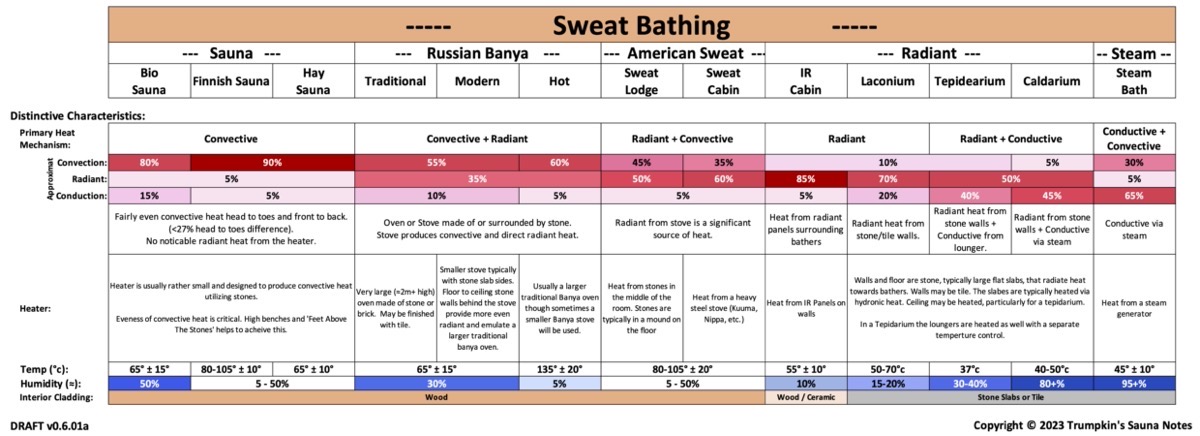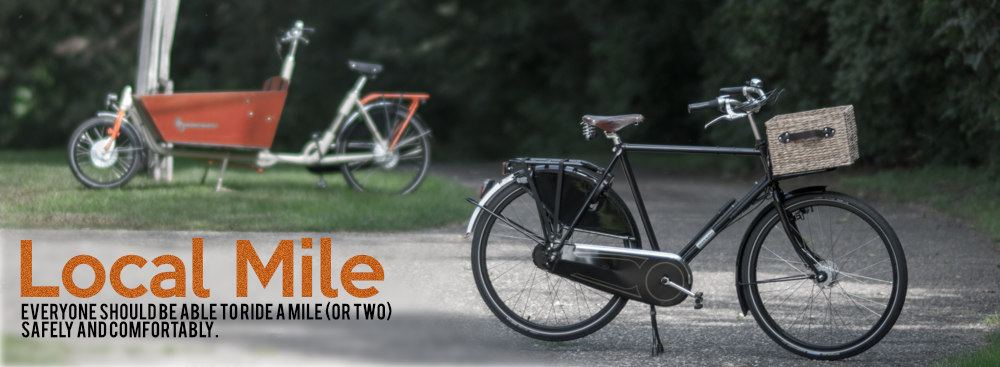—— DRAFT ——
What Is Sauna?
Sauna is the practice of sweating in a high temperature low humidity room followed by quickly cooling off and then possibly repeating the process several times.
The Finnish Sauna Society recommends temperatures in the range of 85-100°c for most bathers though anywhere from 70-105°c is appropriate.

What Is A Sauna?
A Sauna is a room, typically of wood, heated to high temperatures by a large mass of stones.
Humidity is generally very dry, perhaps 5-10% RH. Bathers ladle water over the stones to produce steam. This steam is a key component of löyly, provides an immediate burst of enjoyable steam and raises the overall humidity.
The stones may be heated by wood fire, gas or electric heaters.
There will typically be two benches; a foot bench, usually located at or slightly above the top of the rocks, and a sitting bench located about 43-45cm (17-18”) above the foot bench. Bathers may sit on either bench though traditionally most prefer the sitting bench.
A sauna is primarily finished with wood. Wood provides for comfortable radiation of heat to bathers and many woods do not usually get so hot as to burn when touched. A portion, such as the wall behind the heater, may be other materials such as stone or metal.
The following sets forth the minimum requirements for a sauna that will meet the needs of most people. Similar experiences that do not meet these criteria are not sauna though may yet be enjoyable and have health benefits similar to sauna. The purpose of this is not to be limiting but to better define what a sauna is so that if someone wants a sauna that they can know that if it meets these criteria that they are experiencing sauna.
1.0 Definitions:
Löyly – The purity, freshness, temperature, evenness and humidity of the air in a sauna. Löyly is critical to sauna. Purity means that the air is pure air and does not contain extraneous elements such as perfume, chlorine, mold, excessive perspiration or other VOCs. Freshness means that the air does not contain excessive CO2 and does contain proper O2 and other elements of natural fresh air. Air that is not a proper temperature, that is stale or not fresh as evidenced by CO2 levels below 700 ppm, or that has significant differences in temperature, freshness or humidity is not löyly.
Traditionally the air is truly not Löyly until steam has been added by ladling water on to the stones and once that is done then the air, assuming it meets the other criteria, is löyly. It is not unusual for bathers to shout ‘LÖYLY!’ when this steam is created and added to the air to make löyly.
Evenness refers to the evenness throughout the sauna room as well as the evenness over time of the temperature and freshness of the air. There should not be dramatic differences throughout the sauna nor should there be rapid changes over time. The larger the mass of stones the more even and pleasant the temperature will be.
Foot Bench / Platform – Typically slightly above the top of the stones. The primary purpose of the foot bench is comfortable access to the sitting bench and for resting feet while sitting. Bathers, particularly young children, may also sit on the foot bench and it is recommended that a suitable place be provided for one or two people if space allows.
Sitting Bench – Typically 40-45cm (16-18”) above the foot bench and 40-48” below the ceiling.
Steps / Platform – Typically 40-45cm (16-18”) below the foot bench. The platform provides navigation space to the foot benches.
Sauna Round – One period of time in the sauna followed by one period of time outside of the sauna cooling off. Time in the sauna may be anywhere from perhaps 5 to 20 minutes. Time outside cooling off may range from a similar time to perhaps one hour or more.
Sauna Session – The total of sauna rounds for a day. Any number of rounds from one to fifty is. Average is about three rounds.
Ladle – Used to ladle water over the stones to create steam.
3.0 Temperature
Adequately high temperatures are critical for the health benefits of sauna, bather enjoyment and good hygiene of the sauna structure and facility. There is a difference in the temperatures that a sauna should be able to maintain and the temperatures desired by bathers.
3.1.1 Requirement: The sauna should be capable of maintaining at least 100°c at bathers heads or shoulders (measured 60-100 cm above the highest sitting bench but no closer than 12cm to the ceiling and 12cm from any walls. Measurement should be met at two sitting positions).
3.1.2 Requirement: Bathers should be able to modify the temperature for their comfort to anywhere between 70°c and 100°c.
3.1.3 Recommendation: A capability of 105°c is appreciated by many people.
3.2.1 Requirement: The temperature at the foot bench for each bather must be within 20°c of the temperature at the bathers head.
3.2.2 Recommendation: Maintain a temperature differential from bathers head to feet on foot bench of no greater than 5°c, or as little differential as possible.
3.3.1 Requirement: The sauna must be capable of maintaining a temperature of at least 65°c for a period of at least 30 minutes along the entire foot bench and sitting bench. This is necessary to eliminate bacteria and mold growth.
Discussion: For electrically or gas heated saunas it is recommended that the thermostat temperature sensor be placed where it will record the same temperatures as bathers at their heads. Typically 12cm below the ceiling and 12-20cm to the right or left of the heater will provide this though the builder should verify this with an accurate digital thermometer and preferably a 2 channel logging thermometer that can indicate the variations between the thermostat sensor and bathers heads.
4.0 Ventilation
Good ventilation for all bathers is critical both for bather health and enjoyment as well as for hygiene of the sauna room. As we breath we significantly increase the CO2 in the room and this CO2 must be exhausted. As well, bather perspiration and any VOCs should be exhausted. In a high occupied space maintaining a low CO2 level will generally also provide enough ventilation to take care other needs.
4.1.1 Requirement: The sauna should be ventilated so that CO2 levels never exceed 700 ppm for any bather.
4.1.2 Recommendation: CO2 levels remain below 500 ppm for all bathers.
4.1.3 Recommendation: In mechanically ventilated saunas provide a means for freshening the air after all use is finished for the day and at routine times otherwise between uses to maintain fresh air.
Discussion: There are numerous ways in which this can be accomplished. As a general rule of thumb about 6 air changes per hour, if well mixed, will accomplish this. Measurement is critical though as it is easy to have 6 air changes per hour that is not well mixed resulting in high and unhealthy levels of CO2, perspiration and VOC’s.
5.0 Stones
Stones are critical to sauna and to löyly. The mass of the stones helps to provide a more mild and comfortable heat without sharp increases and decreases. Ladling water on to the stones produces a comfortable and healthy steam along with negative ions.
5.1.1 Requirement: A mass of at least 20kg of stones.
5.2.1 Recommended: A mass of 40kg of stones plus 10kg per person (or per each 2 cubic meters of room volume) or more.
7.0 Design Considerations
7.1 Size and Dimensions
7.1.1 Total Volume of Space. Approximately 2 m3 per bather is recommended.
7.2 Materials
The materials used in a sauna affect both the bather experience and safety. Wood absorbs heat and then slowly radiates this heat back in to the room which helps to create a pleasurable ‘soft-heat’ experience. Materials such as glass produce a harsher reflected heat and so their use should be limited. Similarly, many materials get quite hot to the touch and can burn and so these materials should be avoided or used in a way that bathers will not come in contact with them.
7.2.1 Recommended: At least 90% of the surface area of walls and ceiling should be an appropriate wood.
7.3 Interior Layout
7.3.1 Entrance Door.
7.3.2 Benches
7.4 Windows
7.5 Additional Facilities
7.5.1 Changing Room
7.5.2 Shower
10.0 Mild Sauna
A Mild Sauna is an optional modification of a standard sauna. A mild sauna may be appropriate in an elderly care facility where lessor temps may be sufficient and lower benches may prove beneficial.
Mild Sauna Temperature: Minimum 90°c at bathers heads and adjustable down to 65°c. While perhaps not necessary, being able to achieve higher temps might be appreciated by some bathers.
Mild Sauna Dimensions: The platform may be at floor level and the foot bench below the top of the rocks. Additional steps to assist in stepping up to the foot bench may be beneficial as well as additional railings to allow those with disabilities to safely navigate without the use of assistive devices.
Mild Sauna Lighting: Sufficiently bright and located so that all benches, steps and railings can be easily seen and distinguished.
Mild Sauna Ventilation: Ventilation may be more important for bathers in a mild sauna and extra care should be taken to insure safe levels.
